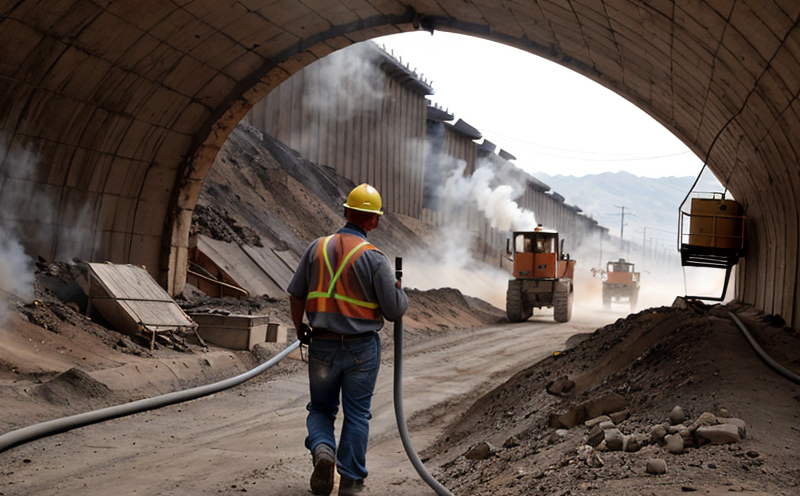ASTM D5337 Mine Air Flow Measurement Testing
The ASTM D5337 standard provides a robust framework for measuring air flow in underground mines. This testing is critical for ensuring the safety and health of mine workers by maintaining optimal ventilation levels that prevent dust accumulation, reduce respiratory hazards, and enhance overall air quality.
Underground mining environments present unique challenges due to confined spaces and the presence of various airborne particles such as silica dust, coal dust, and other particulates. Proper measurement of air flow is essential for effective ventilation control. This ensures that harmful substances are adequately dispersed or removed from the mine atmosphere, thereby protecting workers from potential health risks.
The ASTM D5337 methodology specifies procedures to measure air velocity in ducts and air passages using anemometers and other appropriate devices. The standard also outlines the need for periodic calibration of these instruments to ensure accuracy over time. This ensures that any discrepancies are identified promptly, allowing for timely adjustments or replacements.
During testing, it is important to consider factors such as temperature, humidity, and pressure within the mine environment, which can significantly affect air flow measurements. Understanding these conditions helps in achieving more precise readings that reflect true operational scenarios. Compliance with ASTM D5337 not only ensures adherence to international standards but also supports best practices in occupational health and safety.
Regular testing according to this standard contributes to improved worker safety by identifying potential issues early on, which can be addressed before they escalate into serious incidents. It plays a crucial role in maintaining regulatory compliance and fostering a safer work environment for all personnel involved in mining operations.
Why It Matters
Proper air flow measurement is vital for ensuring the safety and health of mine workers. By adhering to ASTM D5337, mining facilities can effectively manage dust levels and other airborne contaminants, reducing respiratory hazards and improving overall air quality.
The standard also supports compliance with local regulations and international best practices in occupational health and safety. Regular testing according to this protocol helps identify potential issues early on, allowing for timely corrective actions that prevent accidents and injuries.
In addition, accurate measurement of air flow is essential for optimizing ventilation systems within mines. This ensures that harmful substances are properly dispersed or removed from the mine atmosphere, contributing to a healthier work environment for all personnel involved in mining operations.
By implementing ASTM D5337 mine air flow measurement testing, facilities can enhance their reputation as leaders in occupational safety and environmental responsibility. This commitment not only benefits workers but also promotes sustainable practices that benefit society at large.
Quality and Reliability Assurance
Ensuring the quality and reliability of air flow measurements is paramount for maintaining a safe working environment in mines. ASTM D5337 provides clear guidelines on how to conduct these tests accurately, ensuring that all measurements are consistent with industry standards.
The standard emphasizes the importance of using calibrated instruments, regular calibration checks, and proper installation techniques when setting up air flow measurement systems. These practices help maintain high levels of accuracy throughout the testing process.
Regular maintenance and calibration of equipment according to ASTM D5337 are crucial for preventing errors that could lead to inaccurate measurements. This helps ensure consistent results across multiple readings, providing a more reliable assessment of air flow conditions inside mines.
In addition, adhering strictly to the protocol outlined in ASTM D5337 ensures that all tests conducted meet international standards, thereby enhancing trust among stakeholders and promoting best practices within the mining industry. By following these rigorous procedures consistently over time, facilities can build a reputation for excellence in occupational safety and environmental responsibility.
Environmental and Sustainability Contributions
- ASTM D5337 contributes to reducing dust pollution by ensuring proper ventilation systems are functioning effectively, thus minimizing the spread of harmful particles into the surrounding areas.
- This standard supports sustainable mining practices by promoting efficient use of resources through optimized air flow management within mines.
- By adhering to ASTM D5337, mining operations can significantly reduce their environmental footprint while enhancing worker safety and health.





